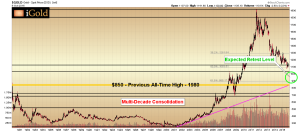Gold is in the process of retesting its breakout from a multi-decade consolidation stretching back to 1980. The significance of such a retest cannot be understated: multi-decade consolidations usually lead to multi-decade advances, with targets many times the previous consolidation high. In percentage terms, gold has only just begun to move above its 1980 former all-time high, and for this reason, we believe it is critical for investors to view this market with sufficient historical perspective.
Multi-decade consolidations are a rare formation in the capital markets. By multi-decade consolidations, we are referring to markets in which an asset makes a specific price high, followed by at least two decades of price action below that high (the consolidation), followed by an eventual breakout above the high. In the case of the gold market, we are referring to the high made in 1980 at $850/ounce, followed by the 28-year consolidation below that high, until the breakout which finally exceeded $850 in 2008.
After oscillating above and below the $850 mark from 2008 through early 2009, gold prices finally took off for good in the fall of 2009, confirming the breakout. As we know, gold continued to accelerate into September of 2011, climbing to above $1,900. Since that time, the precious metal has been in a four year bear market, standing just above $1,140 as this article goes to press.
The critical piece of data in this chronicle is that the current four-year bear market has occurred entirely above the 1980 high. What this means is that this bear market represents a retest of the breakout from the former multi-decade consolidation.
Continue reading the full article on Gold-Eagle.com…

